It’s no exaggeration to say that skiing is the most popular winter sport. Sure, snowboarding is WAAAY cooler (according to snowboarders, at least!), but skiing predates snowboarding by many years and will always be the premier winter sporting activity.
There is nothing to beat the sensation of schussing down a mountain with a couple of planks strapped to your feet. Whether you enjoy the occasional skiing holiday or are a dyed-in-the-wool powder hound, skiing gets in your blood. Once you are bitten by the skiing bug, you’ll be an addict for life.
While you can hire skis, a lot of skiers prefer to buy their own, and that’s where things start to get tricky. That’s because there are lots of different types of skis, and each has different characteristics.
Because of this, it pays to know a little about the different types of skis so you can buy, rent or borrow the ones that are right for you.
In this guide, we take a look at the different types of skis and discuss the pros and cons of each so you can choose the best planks for your preferred style of skiing.
Types of skis
Broadly speaking, there are two types of skis – alpine skis and Nordic skis. Alpine skis have bindings that hold your entire foot on the ski, while Nordic skis only bind the front of your foot, so your heel is free to lift. Ski shapes then vary depending on what type of skiing you are going to use them for.
- Types of skis: Alpine Skis
- Types of skis: Nordic Skis
Disclaimer: We use affiliate links and may receive a small commission on purchases.
Alpine skis
The main types of alpine skis are:
All-mountain skis
BEST FOR: Recreational downhill skiing on most types of terrain
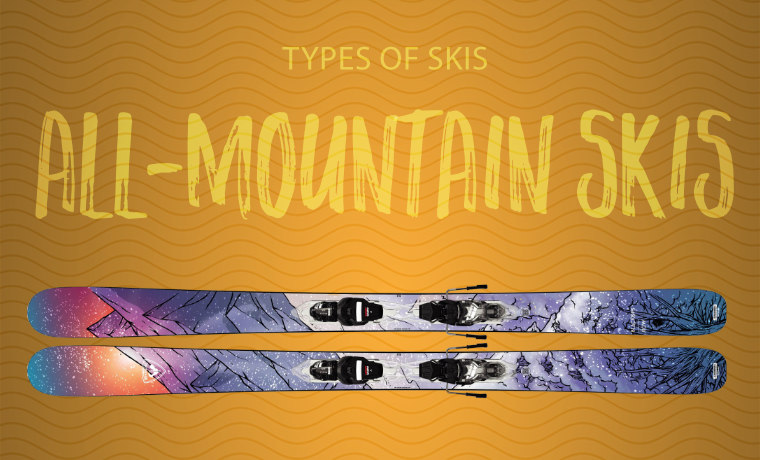 All-mountain skis are ideal for anyone who wants to do a bit of everything. They’re one of the best types of skis for beginners and a great choice for skiing generalists who enjoy skiing on all types of snow.
All-mountain skis are ideal for anyone who wants to do a bit of everything. They’re one of the best types of skis for beginners and a great choice for skiing generalists who enjoy skiing on all types of snow.
All-mountain skis are not the fastest or most agile type of skis, but unless you are a very proficient skier, you probably won’t exceed the performance limits of all-mountain skis.
Pros
- Suitable for most types/styles of skiing
- Ideal for all levels of proficiency
- Reasonably fast and agile
- Excellent all-round recreational skis
Cons
- Not the fastest skis
- Not so good for carving sharp turns
- Experienced skiers may find they lack performance
Big mountain skis
BEST FOR: Advanced, off-piste skiing
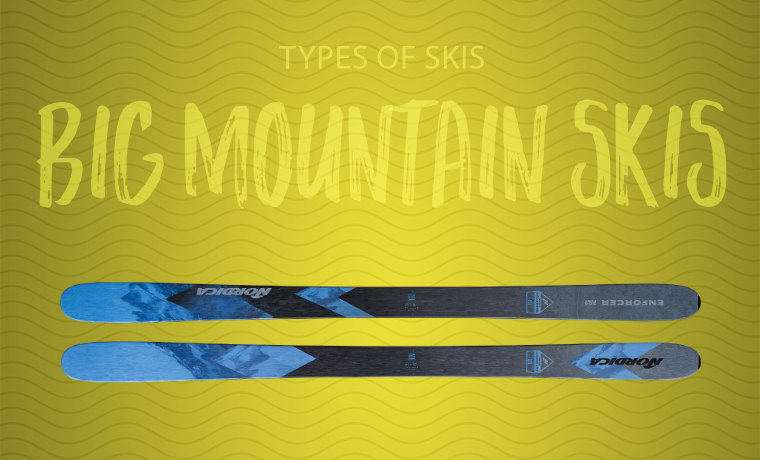 Although they sound similar, big mountain skis are a little different to all-mountain skis. Big mountain skis are designed for extreme skiing, e.g., heliskiing from the summit of the mountain all the way back down to your chalet. Wider, longer, and stiffer than most other types of skis, these skis are the extreme rally car of the skiing world.
Although they sound similar, big mountain skis are a little different to all-mountain skis. Big mountain skis are designed for extreme skiing, e.g., heliskiing from the summit of the mountain all the way back down to your chalet. Wider, longer, and stiffer than most other types of skis, these skis are the extreme rally car of the skiing world.
Pros
- Best skis for advanced, aggressive skiers
Cons
- Not suitable for beginners
- Not especially fast
- Not the best on-piste skis
Powder skis
BEST FOR: Skiing off-piste in deep powder
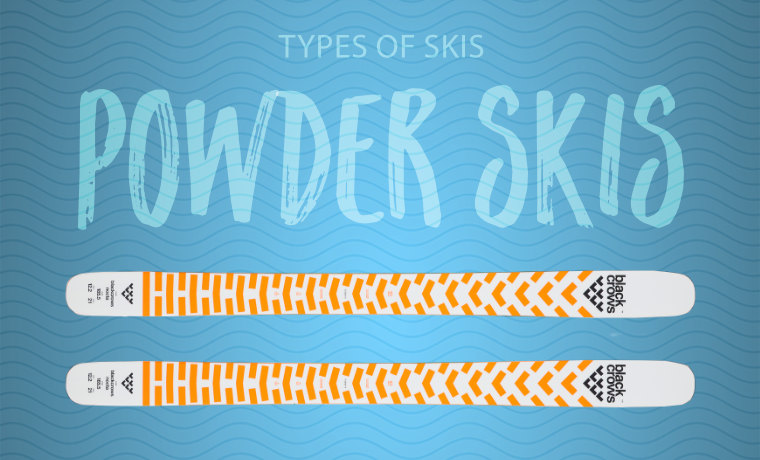 Trying to ski in deep powder with narrow skis is a recipe for disaster, as the small surface area means you’ll probably sink up to your knees! Powder skis are wider and can cope with even the deepest snow. They also feature a more curved tip, so your ski won’t dig into the snow and send you head-over-heels.
Trying to ski in deep powder with narrow skis is a recipe for disaster, as the small surface area means you’ll probably sink up to your knees! Powder skis are wider and can cope with even the deepest snow. They also feature a more curved tip, so your ski won’t dig into the snow and send you head-over-heels.
Pros
- Best for off-piste skiing
- Wide and stable
- Good intermediate skis
Cons
- Not the best for carving sharp turns
- Can be quite slow
- Not ideal for beginners
Snowblades
BEST FOR: Having fun, especially as a beginner
 Also known as ski blades, short skis, or ski boards, this type of ski is very versatile. They come in various lengths and are designed for recreational skiing and having fun! They’re all-rounders that you can use for a range of skiing activities, both on and off-piste. Snowblades are an excellent choice for novices as well as intermediates who just want to play in the snow.
Also known as ski blades, short skis, or ski boards, this type of ski is very versatile. They come in various lengths and are designed for recreational skiing and having fun! They’re all-rounders that you can use for a range of skiing activities, both on and off-piste. Snowblades are an excellent choice for novices as well as intermediates who just want to play in the snow.
Pros
- A versatile ski that’s suitable for a range of activities
- Short and stable, so good for learners and beginners
Cons
- Not especially fast
- Not suitable for deep powder (they sink!)
Freestyle skis
BEST FOR: Skiing in the park and half pipe, and for doing tricks
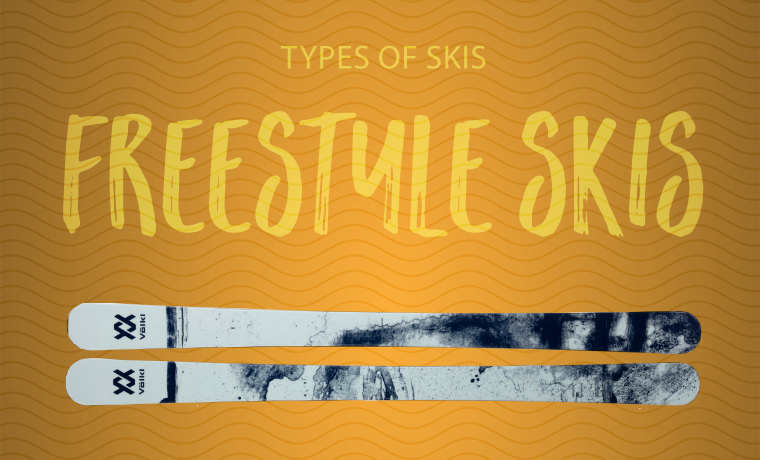 The most obvious difference between freestyle skis and most other ski types is that they have upturned tips at both ends so you can ski forward AND backward. Freestyle skis, also known as park and pipe skis, are made for jumps, turns, and other tricks. They’re primarily used in snow parks, but you can “hot dog” and strut your stuff on other parts of the mountain, too.
The most obvious difference between freestyle skis and most other ski types is that they have upturned tips at both ends so you can ski forward AND backward. Freestyle skis, also known as park and pipe skis, are made for jumps, turns, and other tricks. They’re primarily used in snow parks, but you can “hot dog” and strut your stuff on other parts of the mountain, too.
Pros
- Best for performing jumps, turns, and other tricks
- Ski forward or backward
Cons
- Not really suitable for beginners
- Not the fastest downhill skis
Freeride skis
BEST FOR: Developing skiers on all types of terrain
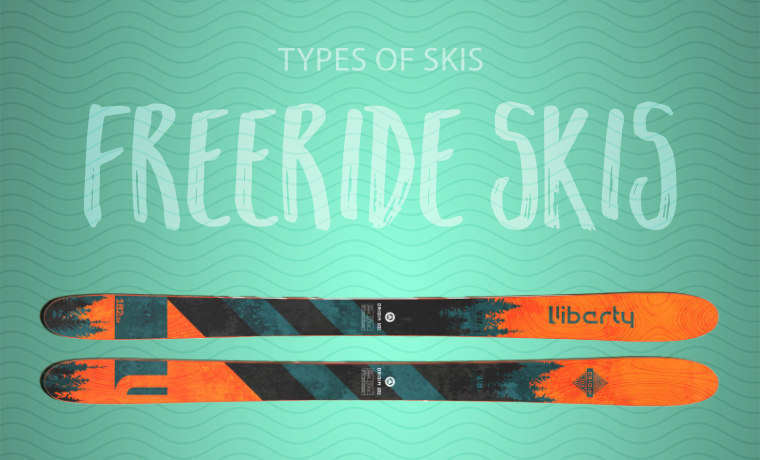 Freeride skis are a lot like powder skis but tend to be shorter, more agile, and a little more versatile. Freeride skis work well on and off-piste, making them great all-rounders. So if you like to spend your mornings on groomed ski runs and then head off-piste in the afternoon without changing your skis, these are the planks for you.
Freeride skis are a lot like powder skis but tend to be shorter, more agile, and a little more versatile. Freeride skis work well on and off-piste, making them great all-rounders. So if you like to spend your mornings on groomed ski runs and then head off-piste in the afternoon without changing your skis, these are the planks for you.
Pros
- Excellent multipurpose skis
- Suitable for a range of skiing activities
- A good choice for late beginners and more advanced skiers
Cons
- Not as fast or as agile as some other types of skis
Carving skis
BEST FOR: Fast, controlled, piste skiing
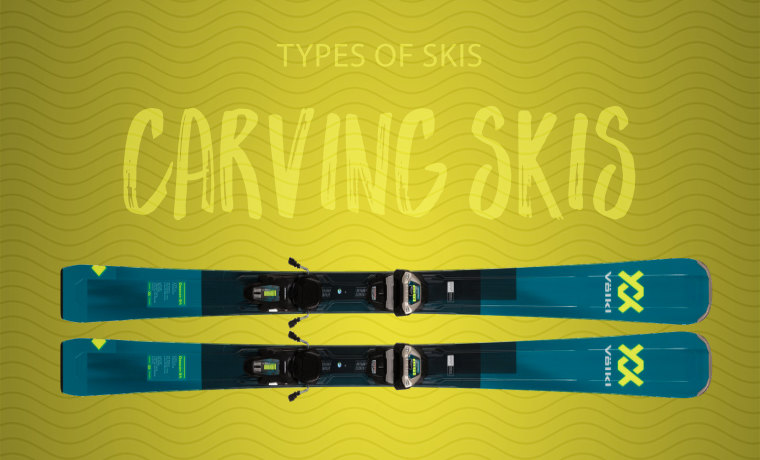 Carving skis are probably the most common type of ski and what most recreational skiers are used to. They have a distinct shape which makes them easier to turn. The edges are curved, which means they naturally want to turn when you put your weight on the edges and “carve” the snow. Carving skis are at home on well-groomed ski runs but aren’t much use off-piste.
Carving skis are probably the most common type of ski and what most recreational skiers are used to. They have a distinct shape which makes them easier to turn. The edges are curved, which means they naturally want to turn when you put your weight on the edges and “carve” the snow. Carving skis are at home on well-groomed ski runs but aren’t much use off-piste.
Pros
- Great for downhill and piste skiing
- Reasonably fast
- Very agile and good for sharp turns
- Suitable for all levels of skier
Cons
- Only really suitable for on-piste skiing
Racing skis
BEST FOR: Going really fast!
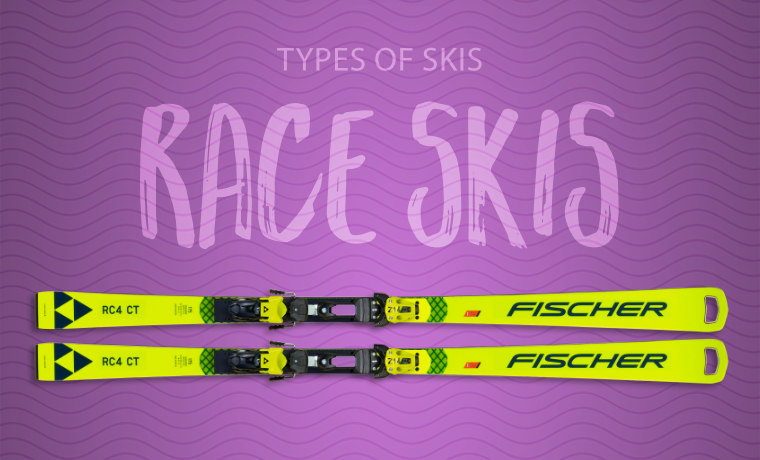 Race skis are long, narrow, and incredibly fast. Top downhill skiers can hit mind-boggling speeds and turn sharply, too. Race skis are flexible and very responsive. However, your ability to turn is somewhat affected by the length of your skis. Long skis are often faster but harder to turn. Racing skis are designed for speed freaks! These skis are the F1 cars of skiing.
Race skis are long, narrow, and incredibly fast. Top downhill skiers can hit mind-boggling speeds and turn sharply, too. Race skis are flexible and very responsive. However, your ability to turn is somewhat affected by the length of your skis. Long skis are often faster but harder to turn. Racing skis are designed for speed freaks! These skis are the F1 cars of skiing.
Pros
- Very fast and agile – with turning circle depending on the length
- Great for downhill and some slalom (especially giant slalom)
- Ideal for well-groomed slopes
Cons
- Not really suitable for beginners
- Longer lengths (200cm+) can be pretty hard to turn
Alpine touring skis
BEST FOR: Ski touring uphill and downhill off-piste skiing
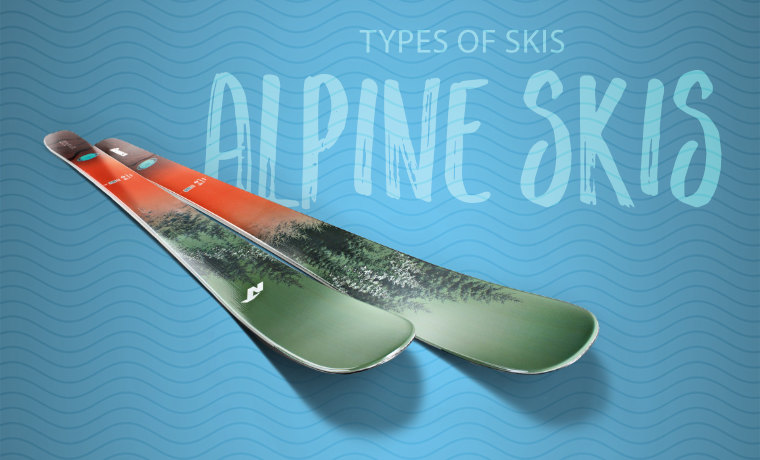 Also known as backcountry skis, these planks are designed for downhill, flat, and uphill skiing. They’re light but stiff and ideal for covering longer distances with relative ease. Most have releasable bindings so you can free your heels and skate. If you want to go exploring, these skis are what you need. They’re available in a range of lengths and widths, with wider skis being better for fresh powder and longer skis being faster.
Also known as backcountry skis, these planks are designed for downhill, flat, and uphill skiing. They’re light but stiff and ideal for covering longer distances with relative ease. Most have releasable bindings so you can free your heels and skate. If you want to go exploring, these skis are what you need. They’re available in a range of lengths and widths, with wider skis being better for fresh powder and longer skis being faster.
Pros
- Good for long-distance skiing
- Very efficient, good for gliding
Cons
- Not especially fast or agile
- Not ideal for beginners
Slalom skis
BEST FOR: Slalom racing
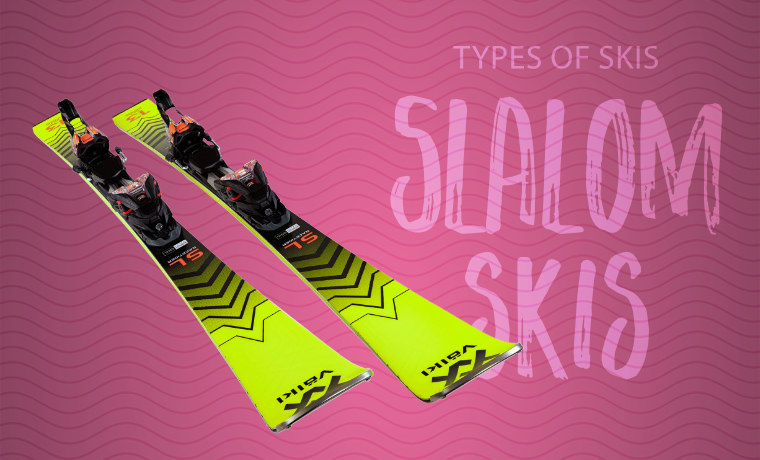 The only reason to buy slalom skis is if you are a competitive slalom skier or that’s what you aspire to be. Made for speed and agility, using slalom skis for anything other than tearing down the mountain at top speed while weaving in and out of poles is like using a rally car on a straight motorway!
The only reason to buy slalom skis is if you are a competitive slalom skier or that’s what you aspire to be. Made for speed and agility, using slalom skis for anything other than tearing down the mountain at top speed while weaving in and out of poles is like using a rally car on a straight motorway!
Pros
- Fast and incredibly agile
- The best skis for slalom racing
Cons
- Not suitable for beginners
- Not really suitable for any other type of skiing
Nordic skis
And finally, it’s time to look at some Nordic skis…!
Cross-country skis
BEST FOR: Travelling across flat or undulating terrain
 Cross-country or Nordic-touring skis are similar to Alpine touring skis in that they are usually light, long, and narrow. However, with Nordic cross-country skis, your heels are free to move, allowing you to skate on the flat and glide downhill. Nordic cross-country skis are sometimes called telemark skis, although telemark skiing is as much about the elegant technique as your choice of skis.
Cross-country or Nordic-touring skis are similar to Alpine touring skis in that they are usually light, long, and narrow. However, with Nordic cross-country skis, your heels are free to move, allowing you to skate on the flat and glide downhill. Nordic cross-country skis are sometimes called telemark skis, although telemark skiing is as much about the elegant technique as your choice of skis.
Pros
- The best touring skis for covering long distances
- Can be used on flat, downhill, and uphill slopes
Cons
- Free-heel skiing is a tricky skill to master, so these skis may not be suitable for beginners
Jump skis
BEST FOR: Ski jumping!
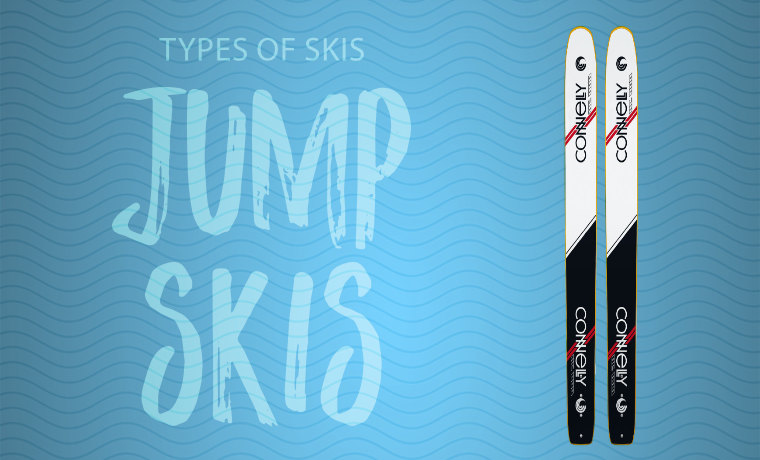 Jump skis are the longest, widest type of ski. In competition, jump skis are usually around 145% of the skier’s height. They’re made of light plastic and shaped for aerodynamics so the jumper can glide (fly? fall?!) as far as possible. Jump skis are very fast, but their length means they are almost impossible to turn. That’s not really an issue, though, as the ramp leading to the jump has groves to follow, and turning is not a requirement.
Jump skis are the longest, widest type of ski. In competition, jump skis are usually around 145% of the skier’s height. They’re made of light plastic and shaped for aerodynamics so the jumper can glide (fly? fall?!) as far as possible. Jump skis are very fast, but their length means they are almost impossible to turn. That’s not really an issue, though, as the ramp leading to the jump has groves to follow, and turning is not a requirement.
Needless to say, like slalom skis, the only reason to buy jumping skis is if you want to try your hand at ski jumping. Rather you than me!
Pros
- The best ski for ski jumping
Cons
- Only suitable for ski jumping!
Types of skis – closing thoughts
The best type of ski is the one that matches the style of skiing you want to do. So, if you want to head off-piste, powder skis or big mountain skis are probably your best choice. But, if you want to use your skis both on and off-piste, all-mountain skis might be the better option.
That said, if you spend all your time on groomed slopes, carving skis are the most logical choice for most people, with racing, slalom, and freeride skis best left to alpine specialists.
If exploring is more your bag, any type of touring ski will suit your needs, although you’ll need to choose between alpine and Nordic binding styles.
Finally, if you want to defy gravity and soar like an eagle, get yourself some jump skis. However, that’s probably not the best choice for most recreational skiers!
The post Types of Skis: Visual Guide With Pros and Cons appeared first on Cool of the Wild.


